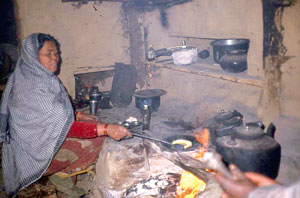 |
Imagine burning a thousand cigarettes in a room and inhaling this smoke everyday. This is what happens in many households across Nepal which burn wood and dried cow dung to use as cooking fuel in their kitchens. No wonder many Nepalis especially women who do the cooking are afflicted with chronic lung disease as early as 40. Many die prematurely because of heart failure, which is secondary to chronic lung disease.
Kirk Smith from the University of California in Berkeley who has been working on indoor air pollution for decades, estimates that each year two million people die worldwide from this pollution. This figure is stunning because it rivals the annual deaths caused by either tuberculosis or malaria, two age-old scourges of humans.
But why has there been no substantial improvement in this area when people have been aware of this problem for decades and clean stoves are easily available? Even in Nepal, researchers including senior physician Migrendra Raj Pandey published an extensive monograph called Chronic bronchitis and corpulmonale in Nepal. This was an epidemiological study conducted in the early 1980s in four areas of Nepal's three different geographical regions.
Yet medical records from hospitals around Nepal (and across South Asia) still point to a disproportionate number of women in their forties and fifties who suffer from chronic lung disease due to wood and cow dung smoke.
Just replacing old stoves with newer, cleaner ones or installing efficient chimneys does not seem to solve the problem. Many national and international organisations are already doing this.
In Nepal a problem is considered to be significant only if it has immediate consequences. Smoke in homes takes years to cause permanent physical ailments like chronic lung disease. People do not seem to mind the initial burning or tearing of the eyes. Some feel that smoke keeps rooms warm, while others believe the roof will cave in with termite infestation in the absence of smoke.
In addition, most researchers barring a few, are foreigners based outside Nepal who are far-removed from this problem. We need young, local, medical and engineering professionals and social workers to solve this unique problem and save the lives of thousands of Nepali women.


